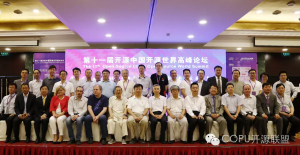I’ve recently had the pleasure to visit Beijing and attend the 11th edition of the “Open Source China Open Source World” summit, organized by the China OSS Promotion Union (COPU). COPU is a non-government organization composed of companies, communities and other players in the software industry, with the goal of promoting the development of Linux and OSS in China. (You can find more information on their website.)
I have been invited to the summit by Emily Chen to represent the GNOME Foundation. This was my first time attending an event of this kind (and my first time in China!), so I was rather curious and didn’t know what to expect!
The summit
The summit lasted one day and a half (June 24-25); the first day had a single track of talks and presentations by representatives of various international and local companies and communities. Many of the “big names” in the industry were there (Intel, Red Hat, SUSE, Linaro, Microsoft, Lenovo, EMC, Alibaba, Huawei, …), and most of the presentations were focused around cloud computing, big data and storage technologies. In the afternoon I gave a presentation about GNOME and Flatpak, called “A new model for application distribution”. I think it was well-received by the audience, even if the topic was rather different from most of the other talks. You can find the slides I used for my presentation here.
The morning of the second day, a round-table discussion was held on the topics of open source, innovation and new economies, with delegates from various companies pitching in their views as to what are the limiting factors for a wider adoption of OSS in China, starting from education and all the way up to the industry, and how that relates to emerging trends such as IoT, cloud computing and AI.
Impressions
The summit was very different from all the other OSS-related events I attended before, and it felt a lot more focused on the business aspect of open source rather than community-building. There’s clearly a lot of interest for open source in China though, and many companies pride themselves for being active contributors or maintainers of projects such as OpenStack, the Linux Kernel, Spark and many more. I was hoping to see more interest in desktop-related technologies, but I don’t think this was actually the best forum for that. Still, I was glad to learn about the deepin OS project, which looks quite cool and seems to share some goals (and code) with GNOME.
Beijing GNOME User Group
After the round-table, the Beijing GNOME User Group (BJGUG) had organized an afternoon event at the local SUSE office, and I gave another presentation about the new features in the upcoming GNOME 3.22 release. You can find the slides I used for my presentation here. Even though me and Emily got there quite late because of the crazy Beijing traffic, people patiently waited for us and the event went nicely, with the audience interacting and asking a lot of questions.
Conclusions
I had a really great time in Beijing, and I hope that my presence helped bringing publicity and more awareness to our project outside of the “typical” OSS channels. Beijing is a huge and fascinating city, and I only had a glimpse into what it has to offer. I spent the day after the summit doing some sightseeing around the Forbidden City, and I felt like I was transported into a different world.
I want to thank Emily Chen, Michael Lee and Cathy Ju for inviting me to the summit and all their help with logistics, Bin Li and the other folks at BJGUG for organizing the afternoon event and for hosting my presentation, and my employer Endless, for supporting my travel to Beijing. Looking forward to next year!








0 comments ↓
There are no comments yet...Kick things off by filling out the form below.
Leave a Comment